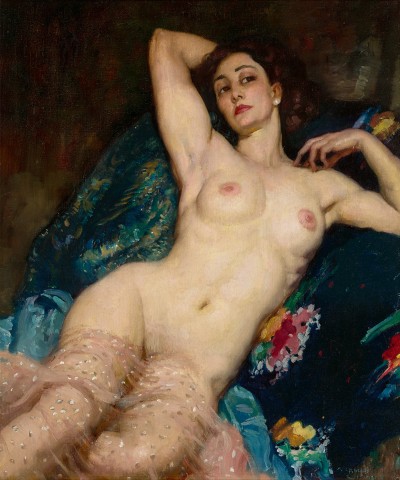LANGOUR, ALSO KNOWN AS THE PINK DRAPE, 1934
NORMAN LINDSAY
oil on canvas on composition board
61.0 x 51.5 cm
signed lower right: NORMAN / LINDSAY
Bloomfield Galleries, New South Wales
Private collection, Canberra, acquired from the above in 2009
Estate of the above
Lindsay, N., & Stewart, D., Paintings In Oil, The Shepherd Press, Sydney 1945, pl. 21 (illus.)
Bloomfield, L., Norman Lindsay: Oil Paintings 1889–1969, Odana Editions, Sydney, 2006, p. 78
Famed for his watercolours and black-and-white art, Norman Lindsay was a relative latecomer to oil paint and only began using it seriously in the mid-1930s. It coincided with a separation from his wife and long-time muse Rose, with Lindsay moving into a new studio in Bridge Street, Sydney, whilst his estranged wife stayed at Springwood, the family home at Faulconbridge in the Blue Mountains. The next years became an incredibly productive period for Lindsay who began attracting a number of new models including those he spotted when attending shows in Sydney’s thriving music halls. As he commented later in 1964, ‘I paid well, I treated my models well, and they liked posing for me. They liked me too.’1 This must have been true for his biographer Lin Bloomfield estimates that between 1930 and 1940, Lindsay used the astounding number of 140 different models, paying them up to ten shillings for a single long sitting. Langour, 1934, is one of the first paintings painted at Bridge Street and although this model has not been firmly identified, she bears a strong resemblance to Gloria Scalis who posed for a clutch of works around the time, such as Repose, c.1933; Lin Bloomfield, however, sees an equal likeness to a model named Cécile who posed for an eponymously titled painting, also from c.1933.
Since the turn of the century, Lindsay was renowned for his vivid drawings of knockabout types and arresting recruitment posters for World War One, his authorship of beloved books such as The Magic Pudding (first published in 1918, it has never been out of print), and – possibly most important to the artist – his spirited attacks on puritanical wowsers in essays, broadcasts and artworks. An avid enthusiast for the hedonistic Dionysian cults of Greek tradition, Lindsay was never a sentimentalist in his depictions of women, commenting that ‘I have utterly repudiated the academic nude image of femininity as an innocuous stuffed dummy designed to decorate the walls of second-class suburban homes… And it appears pretty clear that I must have successfully infused sexual desirability into my women, else they never would have aroused such infuriated howls from the massed ranks of suburbia.’2
Regardless of identity (or politics), Langour is a superb painting by an artist at the height of his game. Lindsay (who was 55 at the time) believed that ‘the best years of a man’s life are the middle years, from his forties (through) his fifties… The reason is obvious. They have gone through the preliminary exercises in a craft and have acquired power of expression. They have fire and passion.’3 Part of the intensity of Langour is due to Lindsay’s use of thin glazes of translucent colour applied to a neutral, though often dark, underpainting. Although he did not enjoy painting hands or feet, the model’s poised left hand is exquisitely observed and rendered. The pink drape, used as a prop in a number of his oils, still survives today, a treasured textile artifact within the Norman Lindsay Gallery, as the family home in Faulconbridge is now known.
1. Norman Lindsay, letter to John Hetherington, 1964, cited in Lin Bloomfield, L., Norman Lindsay: oil paintings 1889-1969, Odana Editions, New South Wales, 2006 p.3
2. Norman Lindsay, letter to John Hetherington, February 1968, cited in Bloomfield, L., ibid., p.10
3. Norman Lindsay, letter to John Hetherington, July 1959, cited in Bloomfield, L., ibid., p.64
ANDREW GAYNOR
